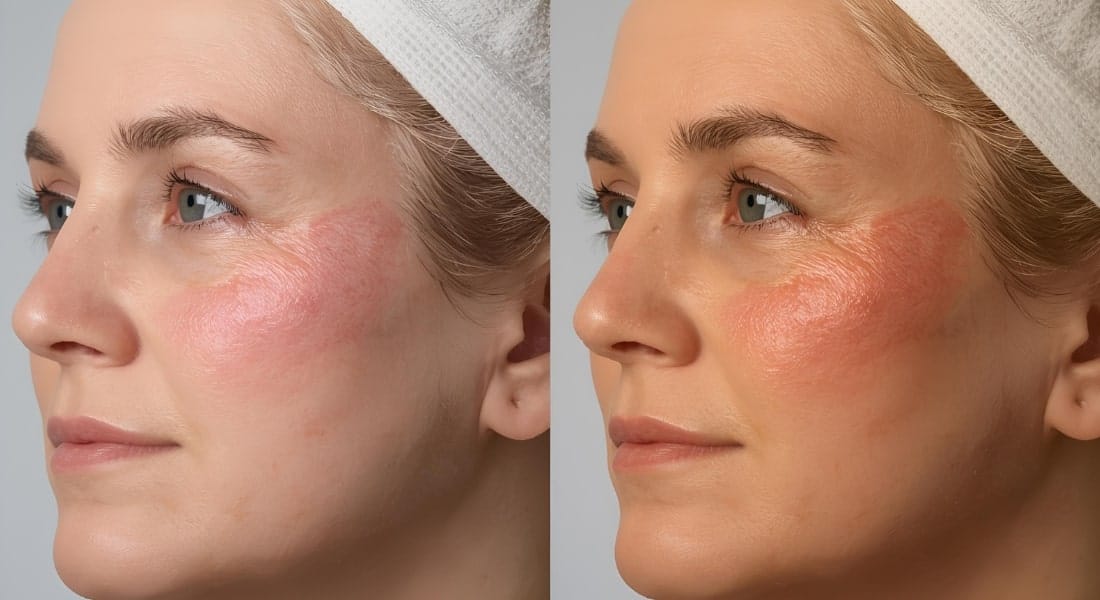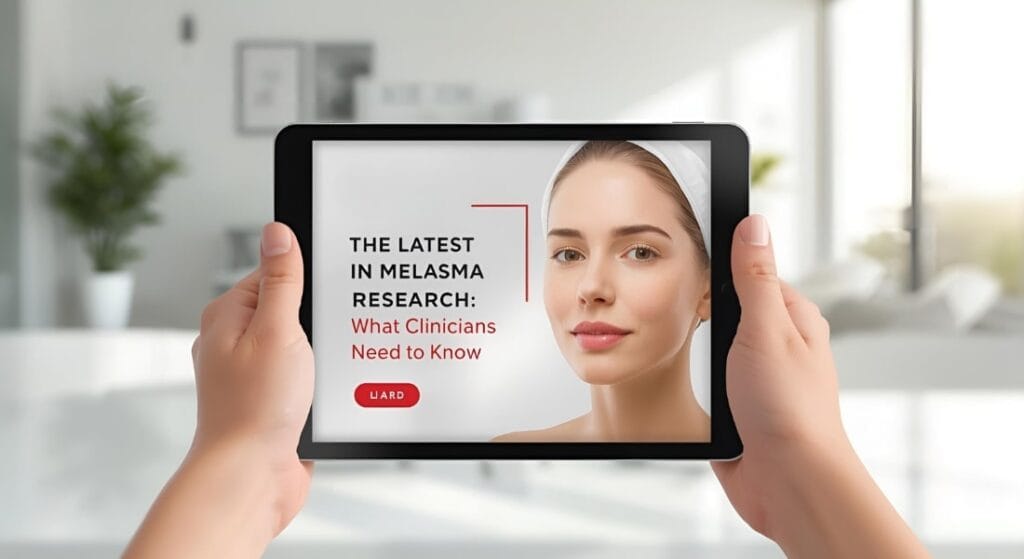Melasma, a chronic and often relapsing hyperpigmentary disorder, remains one of the most therapeutically challenging conditions in aesthetic dermatology. While the clinical presentation is familiar, the underlying pathogenesis is increasingly understood as a complex interplay of melanocyte hyperfunction, vascular dysfunction, and dermal changes. As new research emerges, the traditional treatment paradigm of hydroquinone and sun protection is evolving into a sophisticated, multi-targeted approach. This article serves as a comprehensive clinical update on the latest melasma research, summarizing the most significant advances from 2023 to 2025 in pathogenesis, therapeutic agents, and procedural protocols. We will provide evidence-based, clinically practical guidance and demonstrate how products like TUBELiTE melaminus and MELINE 05 PIGMENT HOME MASK can be integrated as key components of a modern pigment management strategy.
Pathophysiology Highlights: What Clinicians Need to Know
Recent research has shifted our understanding of melasma from a simple melanocyte disorder to a more holistic view of the skin as a single, interdependent organ. The traditional focus on melanocyte hyperactivity (the overproduction of melanin) is now complemented by a deeper appreciation for the role of the skin’s microenvironment. New insights include:
- Vascular Component: Melasma-affected skin shows increased vascularity and overexpression of vascular endothelial growth factor (VEGF). The interaction between melanocytes and endothelial cells is a key driver of pigmentation. This means targeting the underlying vascularity is now a viable therapeutic approach, not just an incidental finding.
- Oxidative Stress: Systemic and localized oxidative stress, driven by UV radiation and pollution, directly contributes to melanocyte activation and persistent pigmentation. This highlights the need for potent topical antioxidants in any treatment protocol.
- Dermal Changes: The dermal layer beneath melasma lesions often exhibits signs of solar elastosis (damage to elastin fibers) and a weakened basement membrane. These structural changes allow for the “dropping” of melanin into the dermis, creating a harder-to-treat dermal component.
- Inflammation and Immune Signaling: Inflammatory mediators and mast cells in melasma lesions contribute to a pro-pigmentary environment, suggesting that managing subclinical inflammation is key to long-term control.
These insights fundamentally change the way we approach treatment. Targeting only melanin production is insufficient. A truly effective protocol must also address vascularity, oxidative stress, and the dermal environment to achieve lasting results and prevent melasma relapse.
What’s New in Topical Agents
Topical therapies remain the foundation of any melasma treatment 2024-2025 protocol. While hydroquinone is still a powerful agent, the focus has shifted to combination therapies and novel actives that target multiple pathogenic pathways, with a particular emphasis on tranexamic acid.
Tranexamic Acid: Oral, Topical, and Beyond
Tranexamic acid (TXA), a synthetic derivative of the amino acid lysine, has emerged as a cornerstone in melasma treatment 2024-2025. It works by inhibiting the plasminogen-to-plasmin pathway in keratinocytes, thereby reducing inflammatory cytokines and growth factors (such as aFGF and ET-1) that stimulate melanocytes. A recent systematic review confirmed TXA’s efficacy, with studies showing significant reductions in MASI scores when used as a monotherapy or in combination.
A key point of clinical discussion is the choice of administration. A recent randomized trial comparing oral versus topical TXA found that both routes were effective, with oral administration (e.g., 250 mg twice daily) showing a slightly better treatment response in some cohorts.
However, oral TXA carries systemic side effect risks, including gastrointestinal upset and, rarely, thromboembolic events. Topical tranexamic acid melasma topical oral preparations (2-5%) offer a safe and effective alternative, particularly for patients with contraindications to systemic therapy. They avoid the risks of oral administration while still providing a targeted anti-melanogenic effect.
Combining Actives for Synergistic Effects
The future of topical therapy lies in sophisticated, multi-ingredient formulations. Combining ingredients that target different pathways—melanin synthesis, inflammation, and skin barrier function—has proven to be more effective and better tolerated than monotherapy. A protocol might combine:
| Ingredient Class | Example Actives | Mechanism of Action |
|---|---|---|
| Tyrosinase Inhibitors | Kojic Acid, Arbutin, Niacinamide | Block melanin synthesis |
| Inflammation Modulators | Tranexamic Acid, Niacinamide | Reduce signaling that activates melanocytes |
| Epidermal Remodeling | Retinoids, AHAs, Salicylic Acid | Increase cell turnover to shed pigmented keratinocytes |
To this end, consider TUBELiTE melaminus as a clinic-grade topical adjunct. Its formulation contains a blend of evidence-backed actives, including kojic acid, arbutin, niacinamide, and tetrahydrocurcumin, which align with current research for multi-targeted melanin inhibition and antioxidant support. TUBELiTE melaminus for melasma can be used as an in-clinic treatment or prescribed as a take-home topical adjunct for patients with epidermal or mixed melasma.
Delivery & Procedural Enhancements: Microneedling and Laser Combinations
To overcome the challenge of limited penetration, clinicians are increasingly turning to procedural enhancements to facilitate the delivery of topical agents and address deeper pigment and vascularity.
Microneedling for Enhanced Penetration
Microneedling (percutaneous collagen induction) has gained significant traction as a powerful adjunct therapy. The procedure creates thousands of microchannels in the epidermis and dermis, which dramatically improves the penetration of topically applied agents. A 2024 systematic review and meta-analysis confirmed that microneedling for melasma is an effective treatment option, particularly when combined with topical TXA (2024). The combination of microneedling with a topical depigmenting solution has shown superior results compared to either modality alone. The mechanism is two-fold: improved drug delivery and the stimulation of a wound-healing response that modulates melanogenesis.
Laser Combinations and Patient Selection
While lasers were once a high-risk option for melasma due to the risk of post-inflammatory hyperpigmentation (PIH), low-fluence Q-switched (LFQS) Nd:YAG lasers have become a popular tool. By delivering energy over a longer pulse duration, LFQS lasers can selectively target pigment without causing significant thermal damage, thereby reducing the risk of PIH. A recent review noted that the judicious use of lasers as part of a combination protocol can be highly effective, especially for dermal or mixed melasma. However, patient selection is paramount. Clinicians must carefully assess Fitzpatrick skin type, prior treatment history, and the risk of rebound hyperpigmentation. Combining LFQS laser with topical tranexamic acid or other pigment inhibitors has shown promising results in controlled studies.
Regenerative & Emerging Biologic Strategies
Beyond traditional therapies, the latest melasma research is exploring regenerative approaches. These emerging biologic strategies aim to modulate the cellular environment to create a healthier, less reactive skin. The most talked-about approach involves exosomes.

Exosomes in Melasma Treatment: A Cautious Optimism
Exosomes are tiny extracellular vesicles secreted by cells, including stem cells. They act as messengers, carrying a payload of proteins, lipids, and nucleic acids that can modulate the behavior of recipient cells. Early pilot studies and preprints suggest that exosomes melasma study protocols, particularly when delivered via microneedling, may help to regulate melanocyte activity and reduce inflammation. The proposed mechanism involves the transfer of signaling molecules that inhibit melanogenesis and promote a more balanced cellular environment.
Exosome Efficacy: Early pilot data indicates potential for significant improvement in MASI scores.
Safety Profile: Pilot studies suggest a favorable safety profile with mild, transient side effects.
Clinical Caution: It is crucial to note that this is still a highly experimental area. The existing evidence comes from small pilot RCTs and preprints (e.g., on Rosa damascena stem cell exosomes) and is not yet robust enough to recommend for routine clinical use. More extensive, multi-center, placebo-controlled trials are needed to validate the efficacy, standardize protocols, and confirm long-term safety before these therapies can be widely adopted. Clinicians should approach these treatments with caution and ensure patients have a full understanding of their investigational nature.
Practical Protocol Templates for Clinicians
Developing a successful professional pigment management protocol requires a stepwise, multi-modality approach tailored to the individual patient. Here are three evidence-based protocol templates based on recent findings.
Protocol 1: Epidermal Melasma (e.g., Wood’s Lamp shows clear enhancement)
Indication: New-onset, epidermal melasma (Fitzpatrick I-III).
Suggested Agents: Morning: a broad-spectrum, pigment-sparing sunscreen. Evening: a topical formula containing depigmenting agents (e.g., tranexamic acid, kojic acid, niacinamide) and a retinoid.
Device Adjunct: N/A (focus on topicals first).
Expected Timeline: 8–12 weeks for initial improvement.
Monitoring: Follow-up every 4 weeks to assess progress and tolerance.
Protocol 2: Dermal/Mixed Melasma (e.g., Dermal/mixed on Wood’s lamp, or refractory to topicals)
Indication: Melasma with a dermal component or a history of poor response to topical monotherapy.
Suggested Agents: Morning: broad-spectrum sunscreen. Evening: multi-ingredient topical (e.g., containing tranexamic acid and niacinamide).
Device Adjunct: Microneedling with topical TXA (e.g., 2.5-5% solution) delivered immediately after the procedure.
Expected Timeline: 4-6 sessions, spaced 2-4 weeks apart.
Relapse Mitigation: For post-procedure maintenance and ongoing melanin suppression, use MELINE 05 PIGMENT HOME MASK between clinic visits to enhance results and reduce melasma relapse prevention risk. This mask contains a powerful blend of actives including azelaic acid, mandelic acid, phytic acid, lactobionic acid, tranexamic acid, and retinal.
Protocol 3: Refractory Melasma (e.g., recalcitrant to all standard therapies)

Indication: Long-standing, recalcitrant melasma, often with significant dermal component.
Suggested Agents: Oral TXA (250 mg twice daily) as an adjunct, in addition to daily sunscreen and a multi-ingredient topical.
Device Adjunct: Consider a combination of low-fluence Q-switched Nd:YAG laser or non-ablative fractional laser to target deeper pigment, followed by the topical application of a depigmenting serum.
Expected Timeline: Individualized. Laser sessions are typically 2-4 weeks apart, with an initial series of 3-6 sessions.
Relapse Mitigation: Strict photoprotection is non-negotiable. Continuous maintenance with topical therapy and the use of MELINE 05 PIGMENT HOME MASK is critical to prevent a rebound flare.
Safety, Side Effects & Regulatory Considerations
As with all treatments, a careful risk-benefit analysis is essential. Oral TXA has a well-documented safety profile but carries a small risk of thrombosis, making it contraindicated in patients with a history of venous thromboembolism. Topical side effects from depigmenting agents can include irritation, erythema, and dryness, especially with high-potency retinoids. The risk of Post-Inflammatory Hyperpigmentation (PIH) after device-based procedures (e.g., lasers, deep peels) remains a significant concern, particularly in patients with darker Fitzpatrick skin types (IV-VI). Clinicians must set realistic expectations and ensure strict adherence to sun protection protocols both before and after procedures to mitigate this risk.
Relapse Prevention & Long-Term Maintenance
The chronic, relapsing nature of melasma is perhaps its most challenging aspect. A successful initial treatment is not a cure. The key to long-term success lies in melasma relapse prevention through meticulous patient education and a robust maintenance strategy.
Photoprotection: This is non-negotiable. Patients must use a broad-spectrum sunscreen daily, year-round, with an SPF of at least 30-50 that also provides protection against visible light. Physical blockers (zinc oxide, titanium dioxide) and tinted sunscreens are often superior due to their ability to block visible light.
Continuous Maintenance Topicals: Patients should continue with a gentle, non-irritating topical regimen that includes tyrosinase inhibitors and antioxidants. Intermittent use of more potent formulas can be considered.
Lifestyle Modifications: Identifying and managing triggers, such as hormonal changes (e.g., oral contraceptives) or excessive heat exposure, is a vital part of long-term control.
Patient Education: Clinicians must be transparent about the chronic nature of the condition and the need for ongoing effort to prevent relapse. Regular follow-up appointments (e.g., every 3-6 months) are essential for monitoring and adjusting the protocol as needed.
B2B Takeaways: How Clinics Should Adapt
The latest melasma research presents a clear directive for modern aesthetic clinics: move beyond single-modality treatments and embrace multi-targeted, evidence-based protocols. For clinic directors and aesthetic physicians, this means a few strategic adjustments:

Operational Integration: Ensure your staff is trained on the latest melasma protocols, including the safe and effective use of devices like microneedling and low-fluence lasers.
Product Sourcing: Stock a diverse range of topical agents that can be combined for customized patient care. A product like TUBELiTE melaminus serves as a versatile take-home adjunct that can be seamlessly integrated into in-clinic procedures.
Expectation Management: Develop a clear patient consent process that explains the chronic nature of melasma, the risk of relapse, and the importance of long-term maintenance.
Protocol Development: Standardize your professional pigment management protocol to ensure consistency in care while allowing for personalized adjustments. Consider how a product like MELINE 05 PIGMENT HOME MASK can be positioned as a value-add for patient post-care and relapse prevention.
Frequently Asked Questions
Q: What are the most promising new therapies for melasma in 2024–2025?
A: The most promising new therapies involve a shift from single-target agents to multi-targeted combination protocols. Key advances include the strategic use of oral and topical tranexamic acid, microneedling-assisted drug delivery, and a cautious exploration of regenerative therapies like exosomes.
Q: How effective is topical tranexamic acid versus oral TXA?
A: A recent randomized trial suggests that both oral and topical tranexamic acid are effective for treating melasma. Oral TXA may show a slightly better response but carries systemic side effect risks. Topical TXA provides a safe and effective local treatment, often used as a long-term maintenance therapy or a co-adjuvant.
Q: Does microneedling improve the delivery of depigmenting agents?
A: Yes, numerous studies and a 2024 systematic review confirm that microneedling creates microchannels that significantly enhance the penetration of topically applied agents, such as tranexamic acid, leading to superior clinical outcomes compared to topical agents alone.
Q: Are exosomes ready for routine clinical use in melasma?
A: No. While emerging pilot studies on exosomes melasma study protocols show promising results, this is still an investigational area. The data is based on small sample sizes, and more robust, large-scale, placebo-controlled trials are needed to establish definitive efficacy and safety for routine clinical practice.
Q: How should clinicians reduce relapse after successful treatment?
A: Relapse is a significant challenge. The best strategies for melasma relapse prevention include strict, year-round photoprotection with a broad-spectrum sunscreen that protects against visible light, continuous use of maintenance topicals (e.g., with mild tyrosinase inhibitors), and patient education on triggers.
Conclusion

The evolution of melasma treatment 2024 – 2025 reflects a deeper scientific understanding of its complex pathogenesis. For clinicians, this means moving beyond a reactive approach to a proactive, multi-targeted strategy that addresses not just pigment production but also inflammation, vascularity, and dermal health. The future of melasma management lies in combining powerful in-clinic procedures with advanced topical solutions and a robust patient-centric maintenance plan. Aakaar Medical Technologies Ltd is committed to providing clinicians with the latest evidence-backed products to support these cutting-edge protocols

